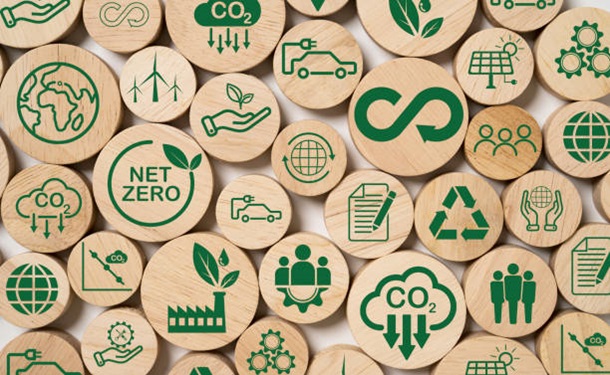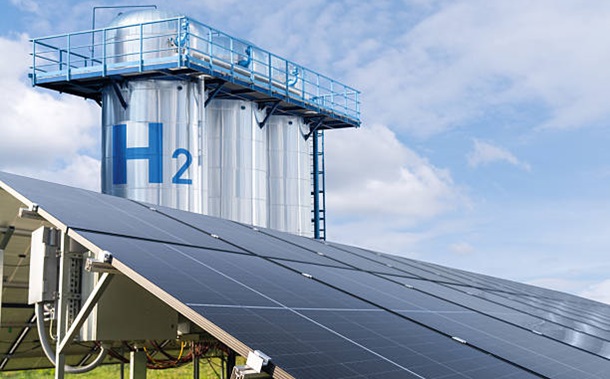The BVAR Model for Analyzing CO2 Emissions on Renewable Energy, Economic Growth, and Forest Area
Downloads
This research investigates the management of CO₂ emissions, a significant factor in the climate change phenomenon, focusing on Indonesia. The objective is to examine the correlation between CO₂ emissions and their causal variables: economic growth (measured by gross domestic product), forest area, and renewable energy (RE) consumption. The Bayesian vector autoregressive (BVAR) model was employed to address the complexity of multivariate interactions and overcome limitations associated with small datasets. The analysis revealed that economic growth and reduced forest area significantly contributed to high CO₂ emissions, while renewable energy consumption exhibited a mitigating effect. The BVAR model demonstrated substantial predictive accuracy, highlighting its suitability for analyzing environmental and economic data in resource-constrained scenarios. These findings emphasize the critical need for targeted policy actions in Indonesia, including safeguarding forest areas, addressing illegal logging and burning, and accelerating the transition to renewable energy. The study provides a novel application of the BVAR model in environmental research, showcasing its potential for generating actionable insights into emissions management. This study contributes to the understanding of sustainable development by proposing an innovative way to support evidence-based policies that reduce CO₂ emissions as well as mitigate climate change impacts.
Downloads
[1] Ahmad, K., Irshad Younas, Z., Manzoor, W., & Safdar, N. (2023). Greenhouse gas emissions and corporate social responsibility in USA: A comprehensive study using dynamic panel model. Heliyon, 9(3), 13979. doi:10.1016/j.heliyon.2023.e13979.
[2] Crippa, M., Guizzardi, D., Pagani, F., Banja, M., Muntean, M., Schaaf, E., ... & Vignati, E. (2023). GHG emissions of all world countries. Publications Office of the European Union, Luxembourg City, Luxembourg. doi:10.2760/953322.
[3] Prasetyani, D., Putro, T. R., & Rosalia, A. C. T. (2021). Impact of CO2 emissions on GDP per capita, FDI, forest area and government spending on education in Indonesia 1991-2020: The GMM methods. IOP Conference Series: Earth and Environmental Science, 905(1), 12131. doi:10.1088/1755-1315/905/1/012131.
[4] Giannelos, S., Bellizio, F., Strbac, G., & Zhang, T. (2024). Machine learning approaches for predictions of CO2 emissions in the building sector. Electric Power Systems Research, 235, 110735. doi:10.1016/j.epsr.2024.110735.
[5] Li, S., Tong, Z., & Haroon, M. (2024). Estimation of transport CO2 emissions using machine learning algorithm. Transportation Research Part D: Transport and Environment, 133, 104276. doi:10.1016/j.trd.2024.104276.
[6] Grolleau, G., & Weber, C. (2024). The effect of inflation on CO2 emissions: An analysis over the period 1970–2020. Ecological Economics, 217, 108029. doi:10.1016/j.ecolecon.2023.108029.
[7] Ganda, F. (2024). The influence of democracy, corruption, economic growth and ICT on carbon emissions in Sub-Saharan African countries: Does FDI matter? Journal of Open Innovation: Technology, Market, and Complexity, 10(3), 100324. doi:10.1016/j.joitmc.2024.100324.
[8] Namahoro, J. P., Wu, Q., Xiao, H., & Zhou, N. (2021). The impact of renewable energy, economic and population growth on CO2 emissions in the east african region: Evidence from common correlated effect means group and asymmetric analysis. Energies, 14(2), 312. doi:10.3390/en14020312.
[9] Chen, X. H., Tee, K., Elnahass, M., & Ahmed, R. (2023). Assessing the environmental impacts of renewable energy sources: A case study on air pollution and carbon emissions in China. Journal of Environmental Management, 345, 118525. doi:10.1016/j.jenvman.2023.118525.
[10] Xie, H., & Bui, W. K. T. (2024). Impact of globalization and energy consumption on CO2 emissions in China: Implications for energy transition. Finance Research Letters, 67, 105939. doi:10.1016/j.frl.2024.105939.
[11] Spodniak, P., Ollikka, K., & Honkapuro, S. (2021). The impact of wind power and electricity demand on the relevance of different short-term electricity markets: The Nordic case. Applied Energy, 283, 116063. doi:10.1016/j.apenergy.2020.116063.
[12] Yu, T., Yong, H., & Liu, L. (2023). MCMC-PINNs: A modified Markov chain Monte-Carlo method for sampling collocation points of PINNs adaptively. Authorea Preprints. doi:10.36227/techrxiv.21971678.v1.
[13] Bianco, V., Cascetta, F., & Nardini, S. (2024). Analysis of the carbon emissions trend in European Union. A decomposition and decoupling approach. Science of the Total Environment, 909, 168528. doi:10.1016/j.scitotenv.2023.168528.
[14] Nihayah, D. M., Mafruhah, I., Hakim, L., & Suryanto, S. (2022). CO2 Emissions in Indonesia: The Role of Urbanization and Economic Activities towards Net Zero Carbon. Economies, 10(4), 72. doi:10.3390/economies10040072.
[15] Raihan, A., Pavel, M. I., Muhtasim, D. A., Farhana, S., Faruk, O., & Paul, A. (2023). The role of renewable energy use, technological innovation, and forest cover toward green development: Evidence from Indonesia. Innovation and Green Development, 2(1), 100035. doi:10.1016/j.igd.2023.100035.
[16] Faruque, M. O., Rabby, M. A. J., Hossain, M. A., Islam, M. R., Rashid, M. M. U., & Muyeen, S. M. (2022). A comparative analysis to forecast carbon dioxide emissions. Energy Reports, 8, 8046–8060. doi:10.1016/j.egyr.2022.06.025.
[17] Raihan, A. (2024). The interrelationship amid carbon emissions, tourism, economy, and energy use in Brazil. Carbon Research, 3(1), 11. doi:10.1007/s44246-023-00084-y.
[18] Ali, A., Audi, M., Senturk, I., & Roussel, Y. (2022). Do Sectoral Growth Promote CO2 Emissions in Pakistan? Time Series Analysis in Presence of Structural Break. International Journal of Energy Economics and Policy, 12(2), 410–425. doi:10.32479/ijeep.12738.
[19] Adebayo, T. S., Awosusi, A. A., Kirikkaleli, D., Akinsola, G. D., & Mwamba, M. N. (2021). Can CO2 emissions and energy consumption determine the economic performance of South Korea? A time series analysis. Environmental Science and Pollution Research, 28(29), 38969–38984. doi:10.1007/s11356-021-13498-1.
[20] Koppel, S., Capellan, J. A., & Sharp, J. (2023). Disentangling the Impact of Covid-19: An Interrupted Time Series Analysis of Crime in New York City. American Journal of Criminal Justice, 48(2), 368–394. doi:10.1007/s12103-021-09666-1.
[21] Prinzi, F., Orlando, A., Gaglio, S., & Vitabile, S. (2024). Breast cancer classification through multivariate radiomic time series analysis in DCE-MRI sequences. Expert Systems with Applications, 249, 123557. doi:10.1016/j.eswa.2024.123557.
[22] Rodhan, M. A. (2024). Macroeconomic Impacts of Oil Price Shocks: Evidence from Iraq by Using Vector Autoregressive Model. International Journal of Energy Economics and Policy, 14(3), 162–170. doi:10.32479/ijeep.15681.
[23] Yollanda, M., Harjupa, W., Devianto, D., Andarini, D. F., Nauval, F., Saufina, E., Purwaningsih, A., Harjupa, W., Trismidianto, Harjana, T., Risyanto, Rahmatia, F., Pratama, R., & Satiadi, D. (2023). Prediction of CENS, MJO, and Extreme Rainfall Events in Indonesia Using the VECM Model. Proceedings of the International Conference on Radioscience, Equatorial Atmospheric Science and Environment and Humanosphere Science, INCREASE 2022, Springer Proceedings in Physics, 290, Springer, Singapore. doi:10.1007/978-981-19-9768-6_35.
[24] Devianto, D., Yollanda, M., Maryati, S., Maiyastri, Asdi, Y., & Wahyuni, E. (2023). The Bayesian vector autoregressive model as an analysis of the government expenditure shocks while the covid-19 pandemic to macroeconomic factors. Journal of Open Innovation: Technology, Market, and Complexity, 9(4), 100156. doi:10.1016/j.joitmc.2023.100156.
[25] Sznajderska, A., & Haug, A. A. (2023). Bayesian VARs of the U.S. economy before and during the pandemic. Eurasian Economic Review, 13(2), 211–236. doi:10.1007/s40822-023-00229-9.
[26] Zhang, S., Ma, X., & Cui, Q. (2021). Assessing the Impact of the Digital Economy on Green Total Factor Energy Efficiency in the Post-COVID-19 Era. Frontiers in Energy Research, 9, 798922. doi:10.3389/fenrg.2021.798922.
[27] Andres-Escayola, E., Berganza, J. C., Campos, R. G., & Molina, L. (2023). A BVAR toolkit to assess macrofinancial risks in Brazil and Mexico. Latin American Journal of Central Banking, 4(1), 100079. doi:10.1016/j.latcb.2022.100079.
[28] Hannaford, N. E., Heaps, S. E., Nye, T. M. W., Curtis, T. P., Allen, B., Golightly, A., & Wilkinson, D. J. (2023). A sparse Bayesian hierarchical vector autoregressive model for microbial dynamics in a wastewater treatment plant. Computational Statistics and Data Analysis, 179, 107659. doi:10.1016/j.csda.2022.107659.
[29] Valencia, F. (2024). Time-Series Modelling and Granger Causality Analysis of GDP and Energy Consumption: The Case of Ecuador 1965–2022. Engineering Proceedings, 77(1). doi:10.3390/engproc2024077006.
[30] Yin, C., Wang, C., Wang, Q., & Ge, Y. en. (2024). Effects of regional freight structure and energy intensity on CO2 emission of transport—a case study in Yangtze River Delta. International Journal of Sustainable Transportation, 18(5), 379–392. doi:10.1080/15568318.2023.2299918.
[31] Cimadomo, J., Giannone, D., Lenza, M., Monti, F., & Sokol, A. (2022). Nowcasting with large Bayesian vector autoregressions. Journal of Econometrics, 231(2), 500–519. doi:10.1016/j.jeconom.2021.04.012.
[32] Doojav, G. O., Purevdorj, M., & Batjargal, A. (2024). The macroeconomic effects of exchange rate movements in a commodity-exporting developing economy. International Economics, 177, 100475. doi:10.1016/j.inteco.2023.100475.
[33] Chan, J. C. C. (2021). Minnesota-type adaptive hierarchical priors for large Bayesian VARs. International Journal of Forecasting, 37(3), 1212–1226. doi:10.1016/j.ijforecast.2021.01.002.
[34] Ameur, H., Njah, H., & Jamoussi, S. (2023). Merits of Bayesian networks in overcoming small data challenges: a meta-model for handling missing data. International Journal of Machine Learning and Cybernetics, 14(1), 229–251. doi:10.1007/s13042-022-01577-9.
[35] Kuschnig, N., & Vashold, L. (2021). BVAR: Bayesian Vector Autoregressions with Hierarchical Prior Selection in R. Journal of Statistical Software, 100(14). doi:10.18637/JSS.V100.I14.
[36] Rudakouski, Y. (2023). Comparing Forecasting Accuracy between BVAR and VAR Models for the Russian Economy. HSE Economic Journal, 27(4), 506–526. doi:10.17323/1813-8691-2023-27-4-506-526.
[37] Kinyar, A., & Bothongo, K. (2024). The impact of renewable energy, eco-innovation, and GDP growth on CO2 emissions: Pathways to the UK’s net zero target. Journal of Environmental Management, 368, 122226. doi:10.1016/j.jenvman.2024.122226.
[38] Raihan, A., Hasan, M. A., Voumik, L. C., Pattak, D. C., Akter, S., & Ridwan, M. (2024). Sustainability in Vietnam: Examining economic growth, energy, innovation, agriculture, and forests’ impact on CO2 emissions. World Development Sustainability, 4, 100164. doi:10.1016/j.wds.2024.100164.
[39] Al-Shetwi, A. Q. (2022). Sustainable development of renewable energy integrated power sector: Trends, environmental impacts, and recent challenges. Science of the Total Environment, 822, 153645. doi:10.1016/j.scitotenv.2022.153645.
[40] Xuan, V. N. (2024). Determinants of environmental pollution: Evidence from Indonesia. Journal of Open Innovation: Technology, Market, and Complexity, 10(4), 100386. doi:10.1016/j.joitmc.2024.100386.
[41] Erdiwansyah, Gani, A., Mamat, R., Bahagia, Nizar, M., Yana, S., Mat Yasin, M. H., Muhibbuddin, & Rosdi, S. M. (2024). Prospects for renewable energy sources from biomass waste in Indonesia. Case Studies in Chemical and Environmental Engineering, 10, 100880. doi:10.1016/j.cscee.2024.100880.
[42] Adeline-Cristina, C., Monica Violeta, A., Codruta, M., & Monica Maria, C. (2025). The moderating role of tourism in the impact of financial crime on deforestation. Journal of Cleaner Production, 486, 144475. doi:10.1016/j.jclepro.2024.144475.
- This work (including HTML and PDF Files) is licensed under a Creative Commons Attribution 4.0 International License.



















